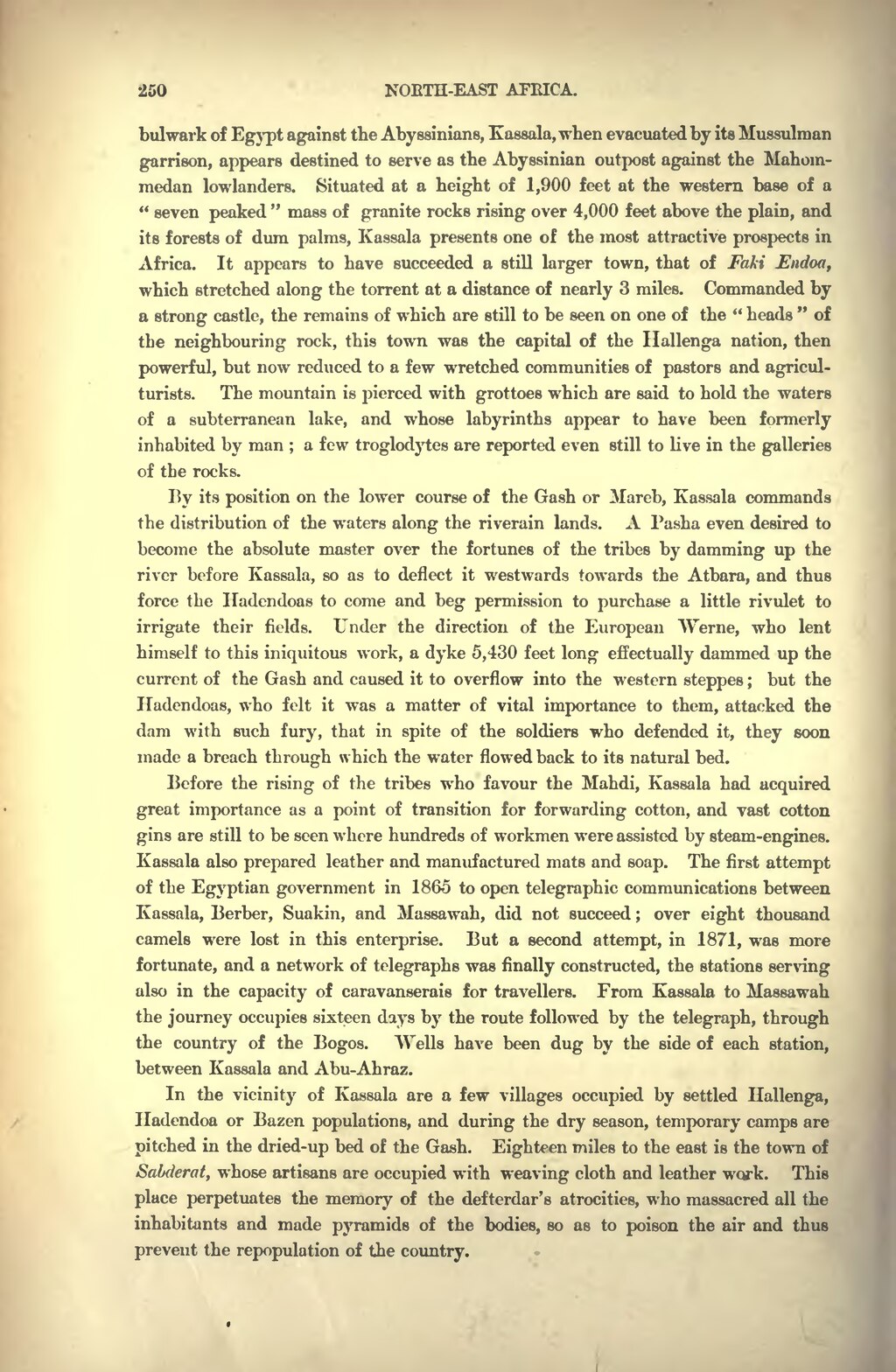250 NOETH-EAST AFMCA. bulwark of Egypt against the Abyssinians, Kassala, when evacuated by its Mussulman garrison, appears destined to serve as the Abyssinian outpost against the Mahom- medan lowlanders. Situated at a height of 1,900 feet at the western base of a " seven peaked " mass of granite rocks rising over 4,000 feet above the plain, and its forests of dum palms, Kassala presents one of the most attractive prospects in Africa. It appears to have succeeded a still larger town, that of Faki Endoa, which stretched along the torrent at a distance of nearly 3 miles. Commanded by a strong castle, the remains of which are still to be seen on one of the " heads " of the neighbouring rock, this town was the capital of the Hallenga nation, then powerful, but now reduced to a few wretched communities of pastors and agricul- turists. The mountain is pierced with grottoes which are said to hold the waters of a subterranean lake, and whose labyrinths appear to have been formerly inhabited by man ; a few troglodj^tes are reported even still to live in the galleries of the rocks. By its position on the lower course of the Gash or Mareb, Kassala commands the distribution of the waters along the riverain lands. A Pasha even desired to become the absolute master over the fortunes of the tribes by damming up the river before Kassala, so as to deflect it westwards towards the Atbara, and thus force the Hadendoas to come and beg permission to purchase a little rivulet to irrigate their fields. Under the direction of the European "Werne, who lent himself to this iniquitous work, a dyke 5,430 feet long effectually dammed up the current of the Gash and caused it to overflow into the western steppes ; but the Hadendoas, who felt it was a matter of vital importance to them, attacked the dam with such fury, that in spite of the soldiers who defended it, they soon made a breach through which the water flowed back to its natural bed. Before the rising of the tribes who favour the Mahdi, Kassala had acquired great importance as a point of transition for forwarding cotton, and vast cotton gins are still to be seen where hundreds of workmen were assisted by steam-engines. Kassala also prepared leather and manufactured mats and soap. The first attempt of the Egyptian government in 1865 to open telegraphic communications between Kassala, Berber, Suakin, and Massawah, did not succeed ; over eight thousand camels were lost in this enterprise. But a second attempt, in 1871, was more fortunate, and a network of telegraphs was finally constructed, the stations serWng also in the capacity of caravanserais for travellers. From Kassala to Massawah the journey occupies sixteen days by the route followed by the telegraph, through the country of the Bogos. Wells have been dug by the side of each station, between Kassala and Abu-Ahraz. In the vicinity of Kassala are a few villages occupied by settled Hallenga, Iladendoa or Bazen populations, and during the dry season, temporary camps are pitched in the dried-up bed of the Gash. Eighteen miles to the east is the town of Sabderat, whose artisans are occupied with weaving cloth and leather work. This place perpetuates the memory of the defterdar's atrocities, who massacred all the inhabitants and made pyramids of the bodies, so as to poison the air and thus prevent the repopulation of the country.
